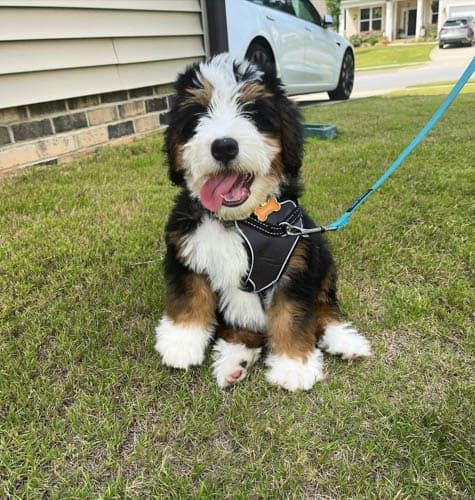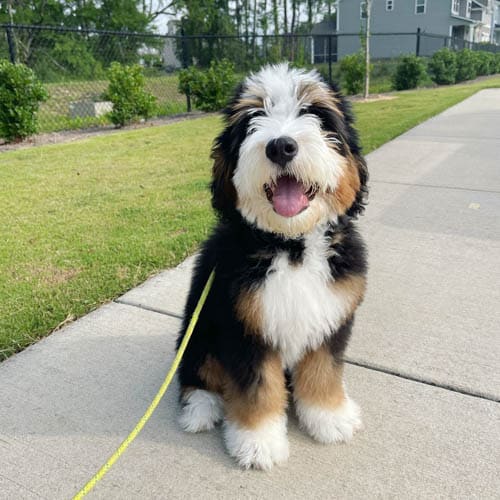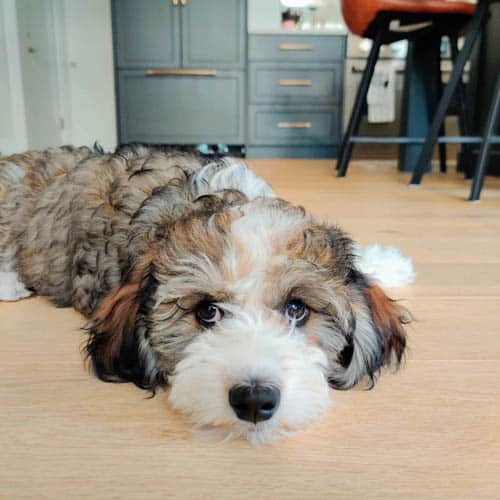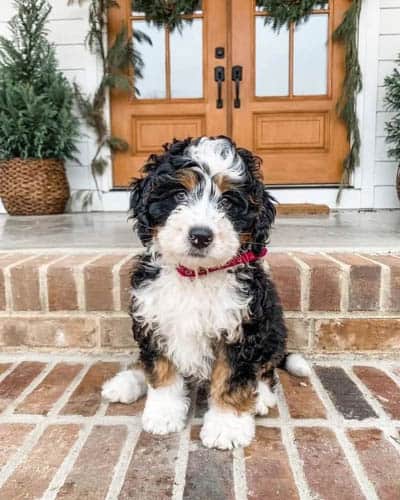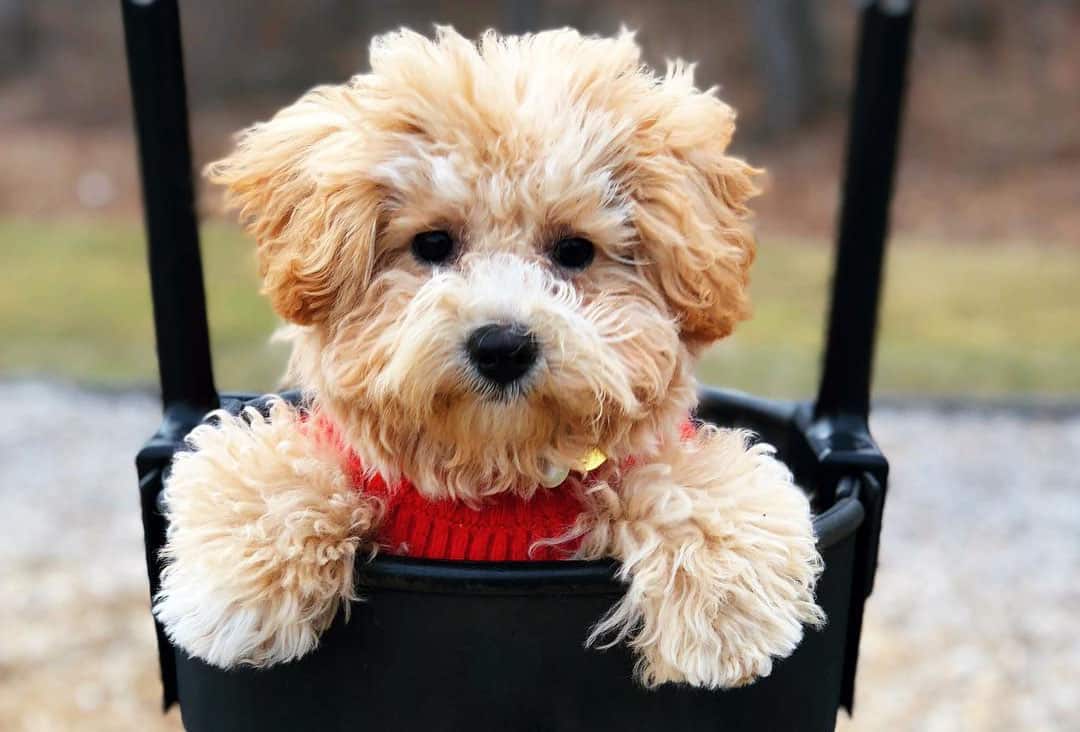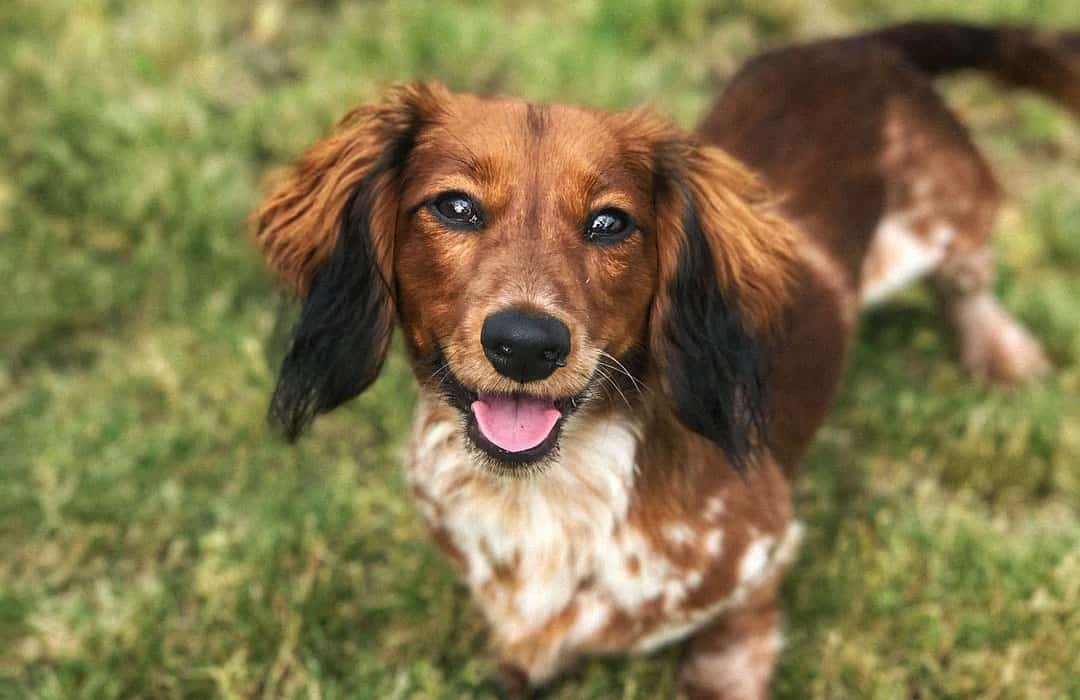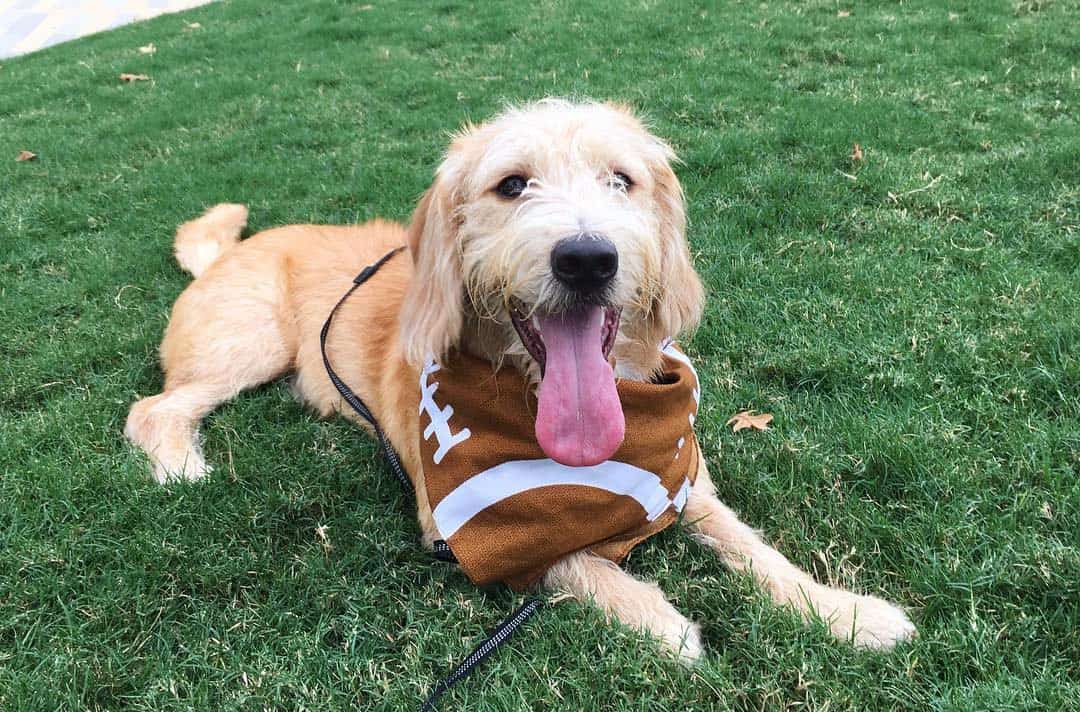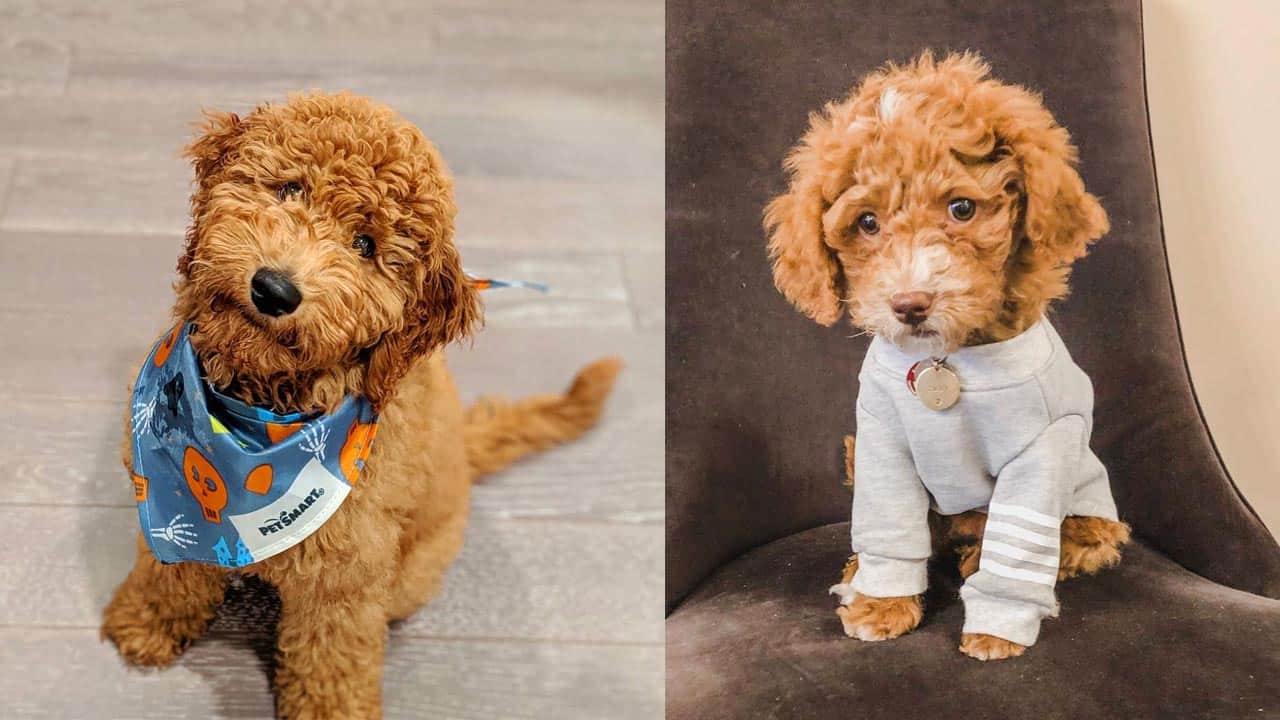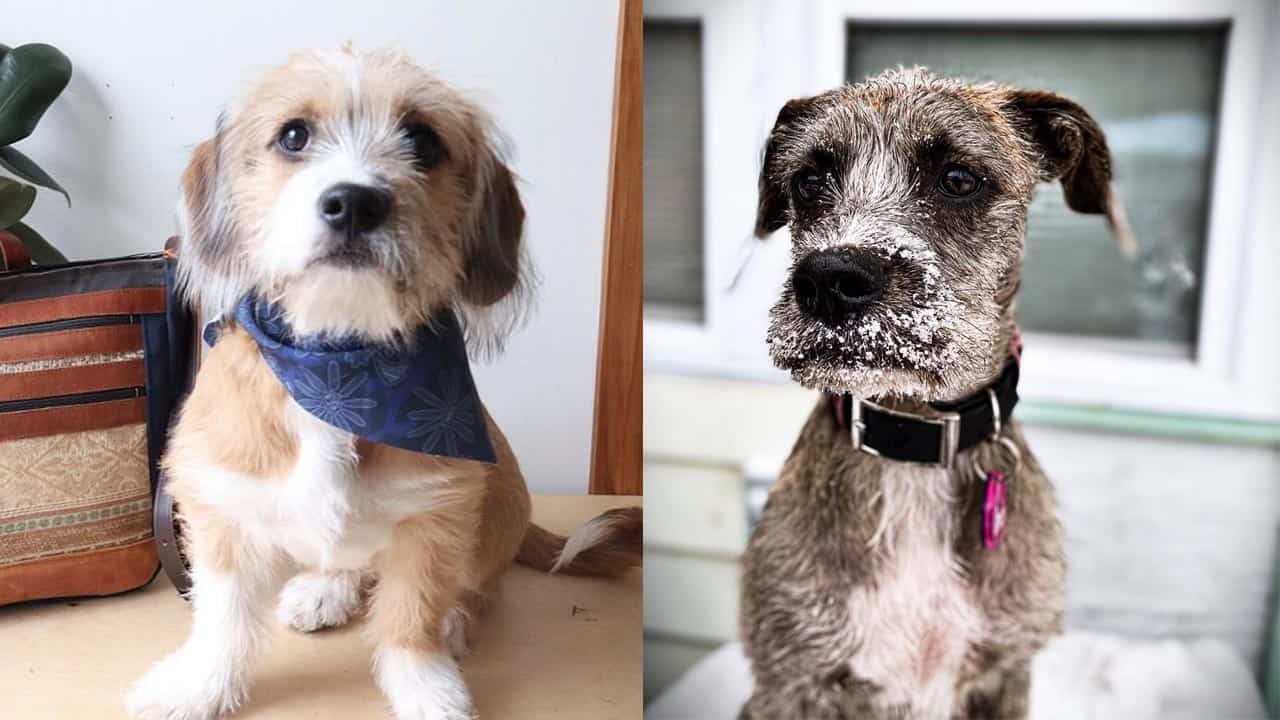Bernedoodle is a companion dog through and through. The breed inherited its intelligence from the Poodle and its charming appearance and easy-going personality from the Bernese Mountain Dog.
These dogs love spending time with their family, including children and willingly participate in outdoor games. So, in this article, let’s know more about full-grown bernedoodle.
About Full Grown Bernedoodle
The breed appeared relatively recently, so the breed characteristics have not yet been fixed in the population. Because of this, some individual dogs are more like poodles in appearance and temperament, while others are more like Bernese Mountain Dogs.
The owners of Bernedoodle unanimously claim that they adore them for their friendliness, intelligence, playfulness, and affection. In addition, the coat of these dogs is hypoallergenic, so they can be recommended for people with allergies.
Bernedoodles can be of different sizes: miniature, small, and standard. The size of the dogs is determined by the size of the Poodle that was used for breeding. Small dogs are better suited for an apartment, while standard Bernedoodles are more comfortable in a private home.
These dogs have moderate exercise requirements, usually met with one long walk a day.
If you’re looking for a family dog, or you’re single and looking for a cute, smart, healthy companion dog, you should consider the Bernedoodle.
History
The Bernedoodle is a relatively new breed. He was bred by breeder Sherry Raupke at SwissRidge Kennels in 2003 and is a cross between a Bernese Mountain Dog and a Poodle. Although, perhaps, a hybrid of these dogs “accidentally” appeared before.
The Bernedoodle is a cross between two purebred breeds and is not recognized by any association other than the International Design Dog Breed Registry and the American Hybrid Kennel Club.
Interest in this designer breed is currently on the rise, and there are already several owners of these loyal, loving, teddy bear-like dogs.
Appearance
If you’re looking for a smart and loyal dog to be your lifelong companion, look no further than Bernedoodle. The intellect and short coat of poodles are combined with the laid-back, devoted personality of the Bernese in these hybrid fluffy pooches, giving you the best of both worlds.
However, while the Bernedoodle should ideally be a perfect mix of parent breeds, hybrids are not guaranteed. Not only can all puppies look different from each other in the litter of fluffy little Bernese Mountain Dogs, each one can have a different personality.
For instance, your Bernedoodle puppy might inherit traits from both of their Poodle parents and become a fluffy Brainiac, or they might retain their Swiss heritage and become a little more stubborn than you anticipated.
In addition, dogs may have health problems that are more common in some breeds than others, depending on their genetic makeup.
Full-Grown Bernedoodle Size:
- At the shoulder, miniature Bernedoodles measure roughly 18 to 22 inches (46 to 56 centimeters). They weigh 24 to 49 lbs. (11-22 kilograms)
- A tiny or toy poodle is under 17 inches (50 centimeters) tall and weighs under 24 pounds. (22 kilograms)
- A Standard Bernedoodle can weigh between 70 and 90 pounds and stand up to 23 to 29 inches (58 to 75 centimeters) at the shoulder. (41-41 kilograms)
Personality
The intelligence of the Poodle combined with the kindness of the Bernese mountain dog: sounds good, doesn’t it? However, not all Bernedoodles have a character that corresponds to this ideal.
Some tend, on the part of the Poodle, to hunt or are more lively than expected. Both breeds are nature lovers, although the Poodle has a reputation as a pampered lapdog. They love to be outside, whatever the weather.
In addition, most are friendly with people and other animals, although some are somewhat aloof with strangers. As with any dog, training takes a long time. However, the Bernedoodle is fairly easy to train, even for beginners.
Not only genes influence the character of animals, but also the phases of socialization and imprinting. A responsible breeder highly values these aspects.
Temperament
Bernedoodles have received many good character traits from Bernese Mountain Dogs and Poodles. However, the specific character traits they inherit from their parents can vary slightly, making each dog unique.
They tend to be very smart and hardworking when necessary, but sometimes they can act a little goofy. These dogs get along well with children and other pets, provided they have socialized properly.
Some Bernedoodles inherit the stubbornness of the Bernese Mountain Dog, which can make them difficult to train; however, this personality trait tends to fade as puppies become teenage dogs.
Bernedoodles, due to their high intelligence, perceive commands in training more easily than most other breeds. However, they can also inherit a cautious attitude towards strangers from the Burns, so the socialization of puppies is extremely important, especially at a young age.
These dogs have high energy levels and require attention and at least moderate daily exercise. They do best in families where they are not left alone for long periods.
Miniature and small Bernedoodles are better for apartment living than standard Bernedoodles. Since large dogs require long daily walks to burn off irrepressible energy.
Living Needs
Regardless of size, your Bernedoodle puppy will need enough activity so they thrive in busy families. Tiny and Mini Bernedoodles may adapt to smaller living spaces with urban situations, such as apartments or condos, and will need less exercise.
In smaller homes, medium to standard-sized Bernedoodles may bump into more coffee tables and have problems fitting in the same hallway with you because they are taller, wider, and may weigh up to 90 pounds. This breed does best with access to a fenced-in yard or a local park to which you can take them!
Nutrition
Bernedoodle comes in three different sizes, so you should choose the right dog food formula for your dog’s size.
Toy and mini Burnedoodles should be offered dog food formulated for small breed dogs, while standard Burnedoodles should be fed large breed formula.
Whatever size you go for at Burnedoodle, you must ensure the dog food formula you choose is high quality from a trusted brand.
While your pup is still in the puppy stage of its life, it is best to choose specially prepared puppy corn as it will contain all the necessary vitamins and nutrients that a developing dog needs to grow into a strong and healthy puppy.
If you don’t know what dog food you can get for your Bernedoodle, check with your veterinarian or breeder – it’s very likely they can tell you the exact information based on your dog’s individual needs.
Life Expectancy:
Since the Bernedoodle is still a new breed being developed, there is not enough information about its lifespan.
Although it is impossible to say how long Burnedowdles live, breeders estimate that the average lifespan of Burnedowdles is between 12 and 15 years.
Of course, small changes are inevitable due to size differences, so the tiny Bernedoodle can live up to 17 years, with standard sizes closer to the shorter end of the range.
Coat:
Bernedoodle come in any combination of white, black, and brown. Many Bernedoodles are all black, some black and white or black and brown.
It is also possible that Bernedoodles will be tricolor or sable – white, black, and brown.
Recently, some breeders have introduced the Bernedoodle merle, which features a marbled white and gray pattern on a black coat. Puppies with this very rare coat type are usually the most expensive.
Just as Bernedoodle differ in breeding, they also have different types of coats. Most Berndoodles have long, wavy coats that fall through minimally.
Curly coats are also very common and small, like the Poodle coat, and are great for allergy sufferers. Flat-coated Bernedadoes are less common and tend to shed more than wavy or curly-coated Bernedoodle.
Care
Miniature and small Bernedoodles are more suitable for living in an apartment, while standard Bernedoodles are better suited for a private home with a spacious backyard. As a general rule, this breed does not need much personal space, and as long as you can meet their physical and mental needs, they should not be overly destructive.
These dogs enjoy being around people, so the less time they spend alone, the better.
Like poodles, Bernadoodles are quite intelligent, meaning they can pick up bad habits as easily as good ones.
Early socialization and getting to know other dogs and people is always a good idea and will help your dog get along well with new people and pets.
The coat of the Bernedoodle can be different and look more like the coat of a poodle or a Bernese Mountain Dog. However, they usually have a wavy, curly coat that does not shed much.
The color can also be different, but usually, the dogs are similar in appearance to the tricolor Bernese Mountain Dogs.
Frequent baths are not indicated for dogs, including Bernedoodle. But, if your dog loves water, then after swimming in the ocean, lake, or river, thoroughly rinse his coat with fresh water.
For bathing, use a dog shampoo specially formulated for rough coats.
Otherwise, Bernedoodle needs, like any other dog, nail care once every few weeks and frequent teeth brushing with a paste approved by veterinarians.
Grooming
Despite the Bernedoodle dog’s teddy bear appearance, don’t underestimate his demands on care and ownership.
Grooming the bernedoodle’s coat is demanding because many have long, wavy hair. The best thing is to get him used to this care from a puppy.
The more curls it has, the fewer hairs the Bernedoodle loses. However, this does not make it easier to care for the coat because if the hair does not fall out, it must be sheared regularly. You do it yourself or take it every three months to the dog groomer.
If the hair is long, it can get tangled, and it is common for the floor to be covered in dirt. Also, an uncared-for Bernedoodle doesn’t feel well and soon starts to smell bad.
Drop ears also require regular checkups. In some specimens, it is necessary to remove the hair from the ears. It is better that you ask your vet for advice.
Health And Diseases
Bernedoodles are generally healthier dogs than their parents. Inbreeding has left many purebred dogs vulnerable to genetically inherited diseases. Therefore, crossing several breeds reduces risks and has a beneficial effect on puppies’ health.
Because the breed is relatively recent, information about health problems in Bernedoodles is somewhat limited. However, fewer cancer cases have been reported in the Bernedoodle than in the Bernese Mountain Dog.
At the same time, there is a certain risk of developing joint dysplasia, eye problems, and skin allergies in the breed, but, in general, the Bernedoodle is a healthy breed.
Before you take a puppy, be sure to ask the breeder about the age of his dogs and the causes of their death.
If a breeder tells you that he doesn’t do genetic testing because his dogs haven’t had health problems or mention any other excuse to save money on genetic testing for their dogs, leave immediately.
Remember that once you’ve brought a new puppy home, you have the opportunity to protect it from one of the most common dog health problems: obesity.
Maintaining a suitable Bernedoodle weight is one of the easiest ways to ensure your dog’s healthier and longer life.
Skin Problems and Tumors:
A frequent problem of the Bernedoodle dog is due to the different coat structures of the parents. This causes some specimens to have skin problems.
In addition, the health of the mixtures depends on the parents. Unlike serious breed breeding, designer dog parents are not necessarily extensively tested before being used for breeding. However, responsible breeders test animals for hereditary diseases.
Hereditary Diseases of the Bernedoodle:
The animal must be tested for hip dysplasia and progressive retinal atrophy for the poodle part.
The Bernese Mountain Dog may also be predisposed to hip dysplasia. For this reason, the breeder must submit the specimens to hip tests before using them.
Genetic tests must be done to detect degenerative myelopathy, a neurological disease typical of the Bernese mountain dog.
Tumors:
The biggest health problem for the Bernese Mountain Dog is malignant histiocytosis. This tumor disease greatly reduces the breed’s average lifespan because many dogs suffer from it.
Responsible breeders work to find dogs that do not transmit the disease through genomic breeding value. This value cannot be determined without knowing the ancestors and genealogical lines. Therefore, much knowledge is required to breed Bernese Mountain Dogs, even if they are mixed.
Conclusion
A trained adult Bernedoodle is less prone to be excitable, destructive, and needy than an untrained puppy. You can learn more about a dog’s personality and health by adopting an adult dog.
Ask breeders if they have any older dogs for sale or if they know of any dogs currently looking for homes if you’re interested in purchasing an older dog from them.
A bernedoodle’s energy level can vary greatly. While the Poodle is a versatile sportsman, the Bernese Mountain Dog takes things more slowly.
Therefore, the sporting activity of the Bernedoodle will depend on whether it is more of a Bernese Mountain Dog or a poodle. In any case, when the dog is an adult, he will enjoy excursions and long walks.
